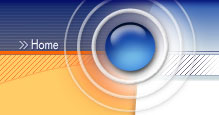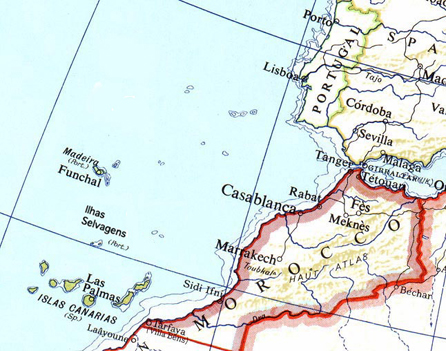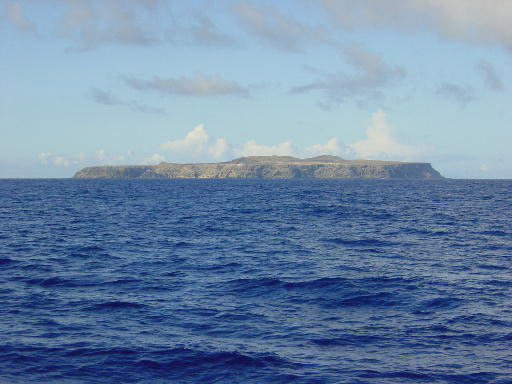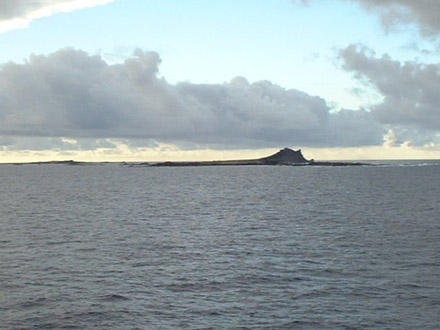| Library | Lane | Search Lane | Catalog |
| Contact Us | Web Site Accessibility |

| Don Macnaughtan | Lane Community
College Library Eugene, Oregon 97405 macnaughtand@lanecc.edu |

|
Bibliography of the Ilhas Selvagens (Savage Islands), Northeast Atlantic Ocean
 2002 Don Macnaughtan
2002 Don Macnaughtan
Island Bibliographies no. 2

Contents
Note on translations
The Portuguese "Ilhas Salvagens" translates as "Savage Islands" in English. However, this is often mistranslated as "Salvage Islands" in English-language citations.
Introduction
The Selvagens archipelago consists of two groups of small islands in the Atlantic Ocean. The main islands are Selvagem Grande, Selvagem Pequena and Ilheu de Fora. Discovered by the Portuguese in the 15th century, they maintained a unique isolation, and resisted any attempt at colonization. Botanically, both Selvagem Grande and the Ilheu de Fora are in quite original condition, which is not the case for other islands in the Atlantic Ocean. From a zoological perspective, they remain a valuable sanctuary for marine birds in the subtropical zone of the north Atlantic.
Due to the rare species and unique conditions, the archipelago has great scientific interest. In 1971, the Portuguese Government acquired the islands and proclaimed a Natural Reserve Area. The archipelago has been certifiied as a natural area by the European Council since 1992, the only area with that unique status in Portugal. It has been guarded over the years by the Vigilantes da Natureza and technical staff from the Parque Natural da Madeira.
The archipelago is situated half way between Madeira and the Canary Islands. Although the islands were known since ancient times, Selvagens was only officially discovered by Portuguese navigators in 1438, earning the name Selvagens (Savages) for being wild and inaccessible in every way.
Selvagem Grande is shaped like a pentagon, with wild topography and a sheer coastline, the result of erosion. It has only two safe anchorages. There is a plateau on top of the island, at 300 feet above sea level.
Selvagem Pequena and the Ilheu de Fora are 11 miles south-west of Selvagem Grande - they are the southernmost part of Portuguese territory.
Web resources
 Madeira Official Website
Madeira Official Website
 Madeira in my Heart
Madeira in my Heart
 Ilhas Selvagens Nature Reserve
Ilhas Selvagens Nature Reserve
"The Selvagens islands include two groups of small islands. Most notable of these are Selvagem Grande, Selvagem Pequena and Ilheu de Fora. They are about 180 miles from Madeira Island and form the southernmost territory belonging to Portugal. The Ilhas Selvagens Nature Reserve was created in 1971 and is one of the oldest in Portugal. Today, it's the only Portuguese reserve formally classified as such by the EC.
"The flora of the Selvagens Islands at its most impressive on Selvagem Pequena and Ilheu de Fora; here grazing animals have never been introduced. Amongst the ninety species that make up the plant heritage of the Selvagens Islands, ten are endemic. Because of the favourable nesting conditions for seabirds, these islands are also known as bird sanctuaries."
 Ilhas Selvagens Reserve
Ilhas Selvagens Reserve
"The last and most southerly point of the Madeira Political Administration is the area known as the Ilhas Selvagens. A group of very small islands, formerly owned by the Rocha Machado family in Madeira, they were declared a nature sanctuary in 1971 when the property ceased to be in the possesion of the family and was turned over to the government. It is currently manned by a few sentries that are relieved every two weeks. The islands are breeding grounds for shearwaters."
 A Voyage to the Ilhas Selvagens
A Voyage to the Ilhas Selvagens
"The Ilhas Selvagens (singular: Ilha Selvagem) are two small but distinct groups of islands and rocks separated by a channel with considerable depths and 8.5 nautical miles wide. The Northern group is composed of Ilha Selvagem Grande (Great Savage Island) and two off-lying rocky islets, Palheiro de Terra and Palheiro do Mar. Ilha Selvagem Grande is uninhabited except for two wardens and two lighthouse keepers. The islands are privately owned and are a protected bird sanctuary. Shearwater seabirds are breeding on the islands.

Selvagem Grande
"A specially protected area, surrounding Ilhas Selvagens extends from the shore to the 200m depth contour. Navigation in this area is prohibited for big ocean going ships. Permission to land, which must be obtained by the Portuguese Embassy in Madeira, is rarely granted.
"The Southern group consists of two islands, Ilha Selvagem Pequena (Small Savage Island) and Ilheu de Fora together with several rocky islets and reefs.

Selvagem Pequena
"Ilha Selvagem Pequena is uninhabited but during the months of July and August it is visited by fishermen from the Canary Islands. It has a low rocky coast faced in many parts by steep beaches of pebbles. The island is for the most part otherwise sandy, undulating and slightly covered with vegetation. The average elevation of the island is between 11m and 14m, but at the North end lies Pico do Veado, 49m (161ft) high, abrupt and conical."
The people and history of Madeira and Macaronesia
 Actas: III Coloquio Internacional de Historia da Madeira. Funchal, Madeira: Centro de Estudos de Historia do Atlantico, 1993. 931p.
Actas: III Coloquio Internacional de Historia da Madeira. Funchal, Madeira: Centro de Estudos de Historia do Atlantico, 1993. 931p. de Azevedo, Alvaro Rodrigues. As saudades da terra: Historia das ilhas do Porto-Sancto, Madeira, Desertas e Selvagens. Funchal: Typ. Funchalense, 1873.
de Azevedo, Alvaro Rodrigues. As saudades da terra: Historia das ilhas do Porto-Sancto, Madeira, Desertas e Selvagens. Funchal: Typ. Funchalense, 1873. Brown, A. Samler. Madeira and the Canary Islands, with the Azores. London: Marston, 1901.
Brown, A. Samler. Madeira and the Canary Islands, with the Azores. London: Marston, 1901. Bryans, Robin. Madeira, pearl of the Atlantic. London: Robert Hale, 1959.
Bryans, Robin. Madeira, pearl of the Atlantic. London: Robert Hale, 1959. Duncan, T. Bentley. Atlantic Islands, Madeira, the Azores and the Cape Verdes in the seventeenth century: commerce and navigation. Chicago: University of Chicago Press, 1972.
Duncan, T. Bentley. Atlantic Islands, Madeira, the Azores and the Cape Verdes in the seventeenth century: commerce and navigation. Chicago: University of Chicago Press, 1972. Guill, James H. The early history of Madeira, 1418-1518. Berkeley, University of California, 1951. 188p.
Guill, James H. The early history of Madeira, 1418-1518. Berkeley, University of California, 1951. 188p. Gregory, Desmond. The beneficent usurpers: a history of the British in Madeira. Rutherford, NJ: Fairleigh Dickinson University Press, 1988. 160p.
Gregory, Desmond. The beneficent usurpers: a history of the British in Madeira. Rutherford, NJ: Fairleigh Dickinson University Press, 1988. 160p. Ludtke, Jean. Atlantic peeks: ethnographic guide to the Portuguese-speaking Atlantic Islands. Hanover, Mass.: Christopher Pub., 1989.
Ludtke, Jean. Atlantic peeks: ethnographic guide to the Portuguese-speaking Atlantic Islands. Hanover, Mass.: Christopher Pub., 1989. Ludtke, Jean. "Madeirans." Encyclopedia of world cultures: volume 4, Europe. Boston: G. K. Hall, 1992. 164-166.
Ludtke, Jean. "Madeirans." Encyclopedia of world cultures: volume 4, Europe. Boston: G. K. Hall, 1992. 164-166. Rogers, Francis M. Atlantic islanders of the Azores and Madeiras. North Quincy, Mass.: Christopher Pub., 1979.
Rogers, Francis M. Atlantic islanders of the Azores and Madeiras. North Quincy, Mass.: Christopher Pub., 1979. Serstevens, Albert. Le periple des iles Atlantides: Madere, Acores, Canaries. Paris: Arthaud, 1966.
Serstevens, Albert. Le periple des iles Atlantides: Madere, Acores, Canaries. Paris: Arthaud, 1966. Underwood, John. Landscapes of Madeira: a countryside guide. London: Sunflower, 1983. 112p.
Underwood, John. Landscapes of Madeira: a countryside guide. London: Sunflower, 1983. 112p.Travel guides to Madeira
 Bolt, Rodney. Madeira & Porto Santo. Cadogan Books, 1999. 288p.
Bolt, Rodney. Madeira & Porto Santo. Cadogan Books, 1999. 288p. Hancock, Matthew. The rough guide to Madeira. New York: Penguin Group, 2001.
Hancock, Matthew. The rough guide to Madeira. New York: Penguin Group, 2001."Lying some 600km off the coast of Morocco, Madeira is an extraordinarily dramatic island of wild mountain scenery and fantastic walking terrain. Combining precipitous valleys and sheer cliffs - including the second-highest sea cliffs in the world at Cabo Girao - the island boasts an astonishingly diverse array of colourful semitropical vegetation and gently cultivated terraces. Understandably, Madeira's natural beauty, along with its year-round mild climate, excellent hotel facilities, gardens and extremely low levels of crime, has long attracted older visitors, and consequently the island has had a reputation as a rather fusty destination for OAPs. However, it is now also attracting a much younger crowd, who are being wooed by the excellent levada walks and the growing number of watersports facilities and adventure sports on offer."
"Madeira and the neighbouring island of Porto Santo were uninhabited until they were discovered and colonized by Portuguese explorers in the fifteenth century. Bang in the middle of a major navigational route in the Atlantic, Madeira quickly established itself as an important trading post, linking Portugal with its colonies in Africa and the Americas. However, its economy only really took off as trade in the island's famous Madeira wine expanded in the seventeenth century. This trade was largely controlled by the British, Portugal's traditional commercial ally, leading to a strong British influence on the island's elite. There are still many Anglo-Madeiran families on the island today, while top hotels like Reid's maintain British customs, such as English teas. However, despite English being spoken just about everywhere, Madeira is very much a Portuguese island: the population is nearly all of mainland Portuguese descent, the signs, food and culture are Portuguese, and so are the superb pastries, powerful coffees and very drinkable table wines."
"As a holiday destination Madeira is relatively cheap, though, as most products have to be imported, it is more expensive than mainland Portugal. Until fairly recently, the island was one of the poorest parts of Portugal and consequently of Europe, and there are rural communities that have only recently been connected to road transport and mains electricity. Rural traditions are still important and the islanders remain conservative in their values. However, they have embraced the European Union with open arms, largely thanks to its funding of a new network of roads and building projects, which have helped propel most of the island into the twenty-first century. Though ancient farming methods on hilltop terraces continue, EU subsidies are updating agriculture and firmly making tourism the number-one source of income for the islanders, especially now the airport has been extended to allow jumbo jets to land."
"However, despite the rash of new development to cater for an expected increase in the number of tourists, equal efforts are being made to preserve Madeira's natural heritage: the island boasts the greatest concentration of virgin lauraceous forests in the world, and an astonishing 66 percent of the island enjoys protected national-park status."
 Hofer, Hans. Insight Guides Madeira. New York: Prentice Hall Travel, 1998. 319p.
Hofer, Hans. Insight Guides Madeira. New York: Prentice Hall Travel, 1998. 319p. Schlecht, Neil. Berlitz Madeira. Berlitz Travel Guides, 2001. 144p.
Schlecht, Neil. Berlitz Madeira. Berlitz Travel Guides, 2001. 144p.Archaeology and prehistoric settlement of the Ilhas Selvagens
 Hansen, Jorg W. "Mauerwerk auf Selvagem Grande (Portugal): Beschreibung und bauliche Wurdigung." Almogaren 31 (2000): 207-221.
Hansen, Jorg W. "Mauerwerk auf Selvagem Grande (Portugal): Beschreibung und bauliche Wurdigung." Almogaren 31 (2000): 207-221. Hansen, Jorg W. "Siedlungsspuren auf den Ilhas Selvagens (Portugal)." Almogaren 32-33 (2001-2002): 287-302.
Hansen, Jorg W. "Siedlungsspuren auf den Ilhas Selvagens (Portugal)." Almogaren 32-33 (2001-2002): 287-302. Steiner, Hartwig-E. "Spekulationen und Thesen zur 'zeitweisen Besiedlung' der Atlantikinsel Selvagem Grande." Almogaren 31 (2000): 223-236.
Steiner, Hartwig-E. "Spekulationen und Thesen zur 'zeitweisen Besiedlung' der Atlantikinsel Selvagem Grande." Almogaren 31 (2000): 223-236. Steiner, Hartwig-E. "Siedlungsspuren auf den Ilhas Selvagens. Dokumentation archaologischer Fundstatten auf Selvagem Grande. Expedition mit dem Forschungsschiff 'Corvette' vom 21.-28. Mai 1999." Almogaren 31 (2000): 193-206.
Steiner, Hartwig-E. "Siedlungsspuren auf den Ilhas Selvagens. Dokumentation archaologischer Fundstatten auf Selvagem Grande. Expedition mit dem Forschungsschiff 'Corvette' vom 21.-28. Mai 1999." Almogaren 31 (2000): 193-206. Ulbrich, Hans-Joachim. "Die Ilhas Selvagens (Portugal) im Spiegel der Geschichte." Almogaren 31 (2000): 143-191.
Ulbrich, Hans-Joachim. "Die Ilhas Selvagens (Portugal) im Spiegel der Geschichte." Almogaren 31 (2000): 143-191. Ulbrich, Hans-Joachim. "Bibliographie der Ilhas Selvagens (Portugal)." Almogaren 31 (2000): 237-262.
Ulbrich, Hans-Joachim. "Bibliographie der Ilhas Selvagens (Portugal)." Almogaren 31 (2000): 237-262.Natural history of the Ilhas Selvagens
 Assing, V. "A new species of Oligota Mannerheim from the Ilhas Selvagens (Coleoptera, Staphylindae)." Reichenbachia 33 (2000): 317-319.
Assing, V. "A new species of Oligota Mannerheim from the Ilhas Selvagens (Coleoptera, Staphylindae)." Reichenbachia 33 (2000): 317-319. Audiffred, P. A. J. Marine algae of Selvagem grande (Salvage Islands, Macaronesia). Funchal, Madeira: Museu Municipal do Funchal, 1983. 31p.
Audiffred, P. A. J. Marine algae of Selvagem grande (Salvage Islands, Macaronesia). Funchal, Madeira: Museu Municipal do Funchal, 1983. 31p. Bannerman, D. A. Birds of the Atlantic Islands: volume 1, a history of the birds of the Canary Islands and of the Salvages. Edinburgh: Oliver & Boyd, 1963.
Bannerman, D. A. Birds of the Atlantic Islands: volume 1, a history of the birds of the Canary Islands and of the Salvages. Edinburgh: Oliver & Boyd, 1963.
 Bischoff, Wolfgang. Die Reptilien der Kanarischen Inseln, der Selvagens-Inseln und des Madeira-Archipels. Wiesbaden: Aula-Verlag, 1998. 448p.
Bischoff, Wolfgang. Die Reptilien der Kanarischen Inseln, der Selvagens-Inseln und des Madeira-Archipels. Wiesbaden: Aula-Verlag, 1998. 448p. Contribucion al estudio de la historia natural de las Islas Salvajes: resultados de la expedicion cientifica "Agamenon 76" (23 de febrero-3 de marzo de 1976). Santa Cruz de Tenerife: Aula de Cultura de Tenerife, 1978. 209p.
Contribucion al estudio de la historia natural de las Islas Salvajes: resultados de la expedicion cientifica "Agamenon 76" (23 de febrero-3 de marzo de 1976). Santa Cruz de Tenerife: Aula de Cultura de Tenerife, 1978. 209p. Denis, J. "Spiders from the Madeira and Salvage Islands." Boletim do Museu Municipal do Funchal 17 (1963): 29-48.
Denis, J. "Spiders from the Madeira and Salvage Islands." Boletim do Museu Municipal do Funchal 17 (1963): 29-48. Gjaerum, Halvor B. Two rust species from the Salvage Islands. Funchal, Madeira: Museu Municipal do Funchal, 1975. 3p.
Gjaerum, Halvor B. Two rust species from the Salvage Islands. Funchal, Madeira: Museu Municipal do Funchal, 1975. 3p. den Hartog, J. C. "Bird observations in the Selvagens Islands." Boletim do Museu Municipal do Funchal 36 (1980): 111-141.
den Hartog, J. C. "Bird observations in the Selvagens Islands." Boletim do Museu Municipal do Funchal 36 (1980): 111-141. den Hartog, J. C. "De Salvagens eilanden, een Portugeesch naturreservat in de Atlantische Oceaan." Artis 27 (1981): 82-90.
den Hartog, J. C. "De Salvagens eilanden, een Portugeesch naturreservat in de Atlantische Oceaan." Artis 27 (1981): 82-90. von Helversen, O. "Scientific expedition to the Salvage Islands. Einige Pseudoskorpione von den Ilhas Selvagens." Boletim do Museu Municipal do Funchal 19 (1963) : 95-103.
von Helversen, O. "Scientific expedition to the Salvage Islands. Einige Pseudoskorpione von den Ilhas Selvagens." Boletim do Museu Municipal do Funchal 19 (1963) : 95-103. Hansen, A. "Flora of Macaronesia. Checklist of vascular plants 4." Sommerfeltia (Oslo) 17 (1993): 1-295.
Hansen, A. "Flora of Macaronesia. Checklist of vascular plants 4." Sommerfeltia (Oslo) 17 (1993): 1-295. Honnorez, Jose. Contribution a l'etude geologique et petrographique de l'archipel des Selvagens. Brussels: Academie royale des sciences d'outre-mer, 1966. 44p.
Honnorez, Jose. Contribution a l'etude geologique et petrographique de l'archipel des Selvagens. Brussels: Academie royale des sciences d'outre-mer, 1966. 44p. Kammer, Franco. Beitrage zu einer kritischen Interpretation der rezenten und fossilen Gefasspflanzenflora und Wirbeltierfauna der Azoren, des Madeira-Archipels, der Ilhas Selvagens, der Kanarischen Inseln und der Kapverdischen Inseln : mit einem Ausblick auf Probleme des Artenschwundes in Makaronesien. Freiburg im Breisgau : F. Kammer, 1982. 179p.
Kammer, Franco. Beitrage zu einer kritischen Interpretation der rezenten und fossilen Gefasspflanzenflora und Wirbeltierfauna der Azoren, des Madeira-Archipels, der Ilhas Selvagens, der Kanarischen Inseln und der Kapverdischen Inseln : mit einem Ausblick auf Probleme des Artenschwundes in Makaronesien. Freiburg im Breisgau : F. Kammer, 1982. 179p. Lopes, M. T. "Littoral sponges from Selvagens Islands." Symposium on fauna and flora of the Atlantic Islands, 1993. Funchal, Madeira: Camara Municipal do Funchal, 1995. 387-391.
Lopes, M. T. "Littoral sponges from Selvagens Islands." Symposium on fauna and flora of the Atlantic Islands, 1993. Funchal, Madeira: Camara Municipal do Funchal, 1995. 387-391. Lowe, Richard T. Floruae salvagiae tentamen: a list of plants collected in the Salvage Islands by Sr Constantino Cabral de Noronha. London: J. Van Voorst, 1869. 24p.
Lowe, Richard T. Floruae salvagiae tentamen: a list of plants collected in the Salvage Islands by Sr Constantino Cabral de Noronha. London: J. Van Voorst, 1869. 24p. Malaquias, M. A. E. "Additions to the knowledge of the opisthobranch molluses of the Selvagens Islands, NE Atlantic, Portugal." Symposium on fauna and flora of the Atlantic Islands, 1998. University of the Azores, 2000. 89-98.
Malaquias, M. A. E. "Additions to the knowledge of the opisthobranch molluses of the Selvagens Islands, NE Atlantic, Portugal." Symposium on fauna and flora of the Atlantic Islands, 1998. University of the Azores, 2000. 89-98. Monod, Theodore. Conspectus florae Salvagicae. Funchal, Madeira: Camara Municipal do Funchal, 1990. 79p.
Monod, Theodore. Conspectus florae Salvagicae. Funchal, Madeira: Camara Municipal do Funchal, 1990. 79p. Neves, H. C. "Analysis of the vegetation of the Ilheu de Fora, Selvagens Islands." Symposium on fauna and flora of the Atlantic Islands, 1993. Funchal, Madeira: Camara Municipal do Funchal, 1995. 505-510.
Neves, H. C. "Analysis of the vegetation of the Ilheu de Fora, Selvagens Islands." Symposium on fauna and flora of the Atlantic Islands, 1993. Funchal, Madeira: Camara Municipal do Funchal, 1995. 505-510. Parente M. I., et al. "Flora marina de las Ilhas Selvagens: resultados preliminares de la expedicion Macaronesia 2000." Revista de la Academia Canaria de la Ciencia 2001.
Parente M. I., et al. "Flora marina de las Ilhas Selvagens: resultados preliminares de la expedicion Macaronesia 2000." Revista de la Academia Canaria de la Ciencia 2001. Perez de Paz, Pedro Luis. Contribucion al estudio de la flora y vegetacion de las Islas Salvajes. Tenerife, Canary Islands: 1977. 46p.
Perez de Paz, Pedro Luis. Contribucion al estudio de la flora y vegetacion de las Islas Salvajes. Tenerife, Canary Islands: 1977. 46p. Press, J. R. Flora of Madeira. London: HMSO, 1994. 574p.
Press, J. R. Flora of Madeira. London: HMSO, 1994. 574p. Press, J. R., M. Biscoito, et al. "New plant records from the Salvage Islands (Portugal)." Bocagiana 90 (1986): 1-4.
Press, J. R., M. Biscoito, et al. "New plant records from the Salvage Islands (Portugal)." Bocagiana 90 (1986): 1-4. Quartau, Jose Alberto. "On a new species of the genus Brachypterona Lindberg (Homoptera: Cicadellidae) from the Salvage Islands." Arquivos do Museu Bocage 10 (1981): 125-132.
Quartau, Jose Alberto. "On a new species of the genus Brachypterona Lindberg (Homoptera: Cicadellidae) from the Salvage Islands." Arquivos do Museu Bocage 10 (1981): 125-132. Read, Helen J. Notes on the vegetation of some Atlantic Islands based on observations made in 1884. Funchal, Madeira: Museu Municipal do Funchal, 1987. 7p.
Read, Helen J. Notes on the vegetation of some Atlantic Islands based on observations made in 1884. Funchal, Madeira: Museu Municipal do Funchal, 1987. 7p. Santos Guerra, Arnoldo. Evergreen forests in the Macaronesian region. Strasbourg: Council of Europe, 1990. 78p.
Santos Guerra, Arnoldo. Evergreen forests in the Macaronesian region. Strasbourg: Council of Europe, 1990. 78p. Selvagens Islands Nature Reserve, Portugal (no. 36). Strasbourg: Council of Europe, 1993. 18p.
Selvagens Islands Nature Reserve, Portugal (no. 36). Strasbourg: Council of Europe, 1993. 18p. Simon, E. "Arachnides recueillis par M. L. Garreta a l'ile Grande-Salvage." Bulletin de la Societe Entomologique de France 81 (1912): 59-61.
Simon, E. "Arachnides recueillis par M. L. Garreta a l'ile Grande-Salvage." Bulletin de la Societe Entomologique de France 81 (1912): 59-61. Weisscher, F. "Marine algae from Selvagem pequena (Salvage Islands)." Boletim do Museu Municipal do Funchal 35 (1983): 41-80.
Weisscher, F. "Marine algae from Selvagem pequena (Salvage Islands)." Boletim do Museu Municipal do Funchal 35 (1983): 41-80. Wollaston, Thomas V. Coleoptera atlantidum: an enumeration of the coleopterous insects of the Madeiras, Salvages, and Canaries. London: J. Van Voorst, 1865. 526p.
Wollaston, Thomas V. Coleoptera atlantidum: an enumeration of the coleopterous insects of the Madeiras, Salvages, and Canaries. London: J. Van Voorst, 1865. 526p. Wollaston, Thomas V. Insecta maderensia: an account of the insects of the islands of the Madeiran group. London: J. Van Voorst, 1854. 634p.
Wollaston, Thomas V. Insecta maderensia: an account of the insects of the islands of the Madeiran group. London: J. Van Voorst, 1854. 634p. Zino, P. A. "The breeding of Cory's Shearwater (Calonectris diomedea) on the Salvage Islands." Ibis 113 (1971): 212-217.
Zino, P. A. "The breeding of Cory's Shearwater (Calonectris diomedea) on the Salvage Islands." Ibis 113 (1971): 212-217.| Lane Community College Library, Center
Building, 4000 East 30th Ave, Eugene, OR 97405 Questions or comments regarding this website can be directed to Don Macnaughtan. Email: macnaughtand@lanecc.edu. This page was last updated: 30 December, 2004 ©2004 Lane Community College |

